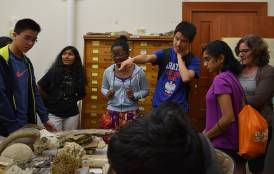News
In an op-ed, Chris Field and Noah Diffenbaugh explain why a rainy winter brought about by a strong El Niño won't be enough to pull California out of drought.
Stanford Earth scientists find that the evidence for a recent pause in the rate of global warming lacks a sound statistical basis.
Brain scans reveal how people make decisions to protect environmental resources and show why environmental philanthropy might be unique.
Stanford students Miyuki Hino, Nina Brooks, and KC McKenna, of the School of Earth, Energy & Environmental Sciences, were captured in a photo alongside a New York Times story on the rise of the University's Economics Department. The women, who are PhD students in the Emmett Interdisciplinary Program for Environmental Resources, are focused on environmental economics.
The extraordinary strength of the present El Niño may lead to a particularly wet winter in California, but Noah Diffenbaugh and Daniel Swain say that it might not be enough to end California's worst drought on record.
A new study co-authord by Ken Caldeira found that burning all the world's coal, oil and natural gas would lead to temperature increases that would melt Antarctica's ice sheet and raise sea level more than 200 feet.
Stanford study proves pipeline replacement programs are effective
Stanford School of Earth, Energy & Environmental Sciences
Ice sheets may be more resilient than thought
Stanford School of Earth, Energy & Environmental Sciences
Arsenic attaches to water that's 'too pure'
Stanford School of Earth, Energy & Environmental Sciences
Study reveals mysterious pathogen in higher concentrations than thought in trailside ticks in the San Francisco Bay Area.
Following the tragic earthquake in Nepal earlier this year, engineers and members of the Nepali Department of Education are using a documentary created by Stanford Earth's Anne Sanquini to inspire earthquake-resistant construction as the country rebuilds.
This year's El Niño might be one of the strongest on record. Stanford Earth PhD candidate Daniel Swain discusses what to expect in California.
Teachers ask the big questions about our changing planet
Stanford School of Earth, Energy & Environmental Sciences
We can't journey to the center of the Earth, but that hasn't stopped us finding out what is down there. Associate Prof. Wendy Mao provides her perspective on studying Earth's interior.
The private library of Stanford's first geology professor, John Casper Branner, was the foundation on which the Branner Earth Sciences Library & Map Collections was built. Branner, Stanford's second president, kept his collection in the Geology Corner, and loaned materials to students, faculty, alumni and all scientists. A case of memorabilia is on display at the library through September.
Educating the next generation: High school interns expand their science frontiers
Stanford School of Earth, Energy & Environmental Sciences
Italian supervolcano research featured on cover of Science
Stanford School of Earth, Energy & Environmental Sciences
Worldview interviewed David Lobell, the Deputy Director of the Center on Food Security and the Environment at Stanford, about how to reduce the risks raised by homogenous crops and increase resilience in our agricultural system.
Ecological Society of America showcases most notable papers
Stanford Woods Institute for the Environment
Stanford Earth's Marshall Burke and Ken Caldeira discuss what is at stake with a changing climate, from rising human conflict to global political tensions that might arise from radical solutions.
Melting glaciers feed Antarctic food chain
American Geophysical Union
Rob Jackson comments on troubling new findings that drought can have lasting "legacy" effects on trees that linger long after water shortages are over.
Stanford scientist's investigations show that drinking water sources may be threatened by thousands of shallow oil and gas wells mined with the controversial process of hydraulic fracturing. A new study suggests safeguards.
E-IPER graduate student Gregory Bratman found that volunteers who walked briefly through a lush, green portion of the Stanford campus were more attentive and happier afterward.



























